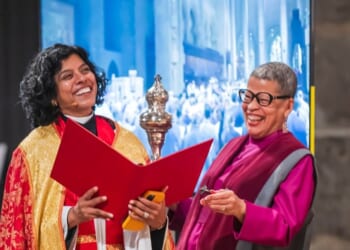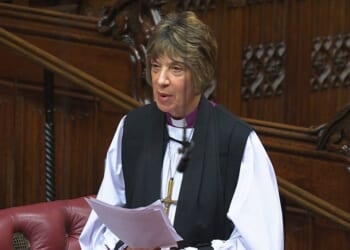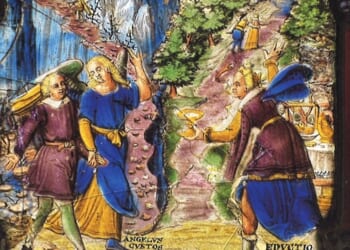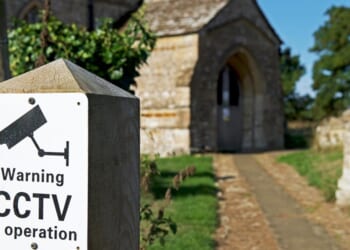AS CHESTERTON remarked, few people set out to be heretics before the 20th century. The term “orthodox” was a Christian neologism, and, as John Arnold points out in his introductory essay, the orthodoxy of the Early Church was partly shaped by the identification of heresy. He rightly observes that many heretics were frequently conservatives rather than radicals, and that the balance of power between sects and the larger Church was not always in favour of the latter.
The consolidation of orthodoxy is, however, the theme of Richard Flower’s chapter on heresiological catalogues (which interestingly contrasts Epiphanius’s multiplication of sects with Theodoret’s gloating over their obsolescence), of Rebecca Rist’s account of the licensing of torture in canon law to defend the faithful from the aggressive perversion of truth, and of Christine Caldwell Ames’s reflections on the zeal of the inquisitor in constructing the heresy that he desires to uproot.
In his chapter on dialogue, Richard Lim warns that we cannot always assume that this aims to be equally fair to all parties; he might have taken more note, however, of the peculiarly Christian custom of recording written or oral debates in full, which means that we do, indeed, know that the Manichaeans, Donatists, Arians, and Pelagians all made points against Augustine which left him avowedly bereft of a strong reply.
The next five chapters examine the retrospective creation of five paradigmatic heresies in the wake of their extinction or absorption into orthodoxy.
Michael Williams argues that the adjective “Gnostic” has functioned from ancient times as a homogenising label for a variety of duality cosmogenies; Jason Beduhn shows that the obvious heterodoxy of Mani encouraged the imposition of the name “Manichaean” on sect after sect that was in reality independent of his teaching; Robin Whelan reminds us that the groups stigmatised collectively as Arians by Athanasius could look for support to councils that they believed to be more Catholic than Nicaea; Ali Bonner finds nothing in Pelagius that would be heterodox except when judged by the innovatory tenets of Augustine; J. Edward Walters depicts a finely balanced conflict between Nestorius and Cyril in which “neither misses an opportunity for insult” — a comment that does scant justice to their forbearance in not comparing each other to any species of reptile, and to Cyril’s artful use of obsequious titles to cast Nestorius in the role of persecutor.
A chapter on the discords (still unresolved) that followed Chalcedon would have been a useful overture to John Tolan’s review of depictions of Islam as a Christian heresy, since Byzantine assailants of the new religion likened it to the Churches that had parted from the main body of Christendom after 451.
One such aberration was iconoclasm, although, as Judith Herrin’s chapter observes, it was for a time enforced as orthodoxy.
Charlemagne’s partial agreement with the defeated iconoclasts may mark the beginning of the process that culminated in Rome’s excommunication of Constantinople in 1064; yet, as Marie-Hélène Blanchet and Nikolaos Chrissis relate, it was not till the 13th century that the schism was inflamed by Western imputations of heresy.
Whereas Christianity was a hairesis, or sect, of Judaism that became a religion, the chapters on Islam and Manichaeism raise the possibility that some heresies may begin as distinct religions.
As Andrew Roach demonstrates, so much remains in doubt concerning the Bogomils that that we cannot say what they were in origin; another fraternity of covert Manichaeans, the Cathars, have been dismissed by some as a mere invention of the inquisitors, although Jörg Feuchter argues that the sceptics are at least equally vulnerable to the suspicion of parti pris.
Pete Biller studies the most protean of all sects, the Waldenses, who appear from forensic records to have defied the inquisitors on several unrelated issues, and in Protestant eyes were proved by this pertinacity to have been mistreated witnesses to the pure gospel.
Lollards, the subject of Patrick Hornbeck’s chapter, were genuine forerunners of Protestantism in their contumacy, their sacramental theology, and their promotion of Bible-reading in the vernacular; it was in Prague, however, that Wyclif’s books were burned, as Pavlína Rychterová shows in a discussion of Jan Hus which struggles to convict him of heresy.
The decision to end before the Reformation spares the editor some difficulties of nomenclature, but leaves us wondering why the perception of Protestantism as heresy, and the perception of heresy within Protestantism, cannot be treated on all fours with the perception of Orthodoxy and Islam.
Dr Mark Edwards is Professor of Early Christian Studies and Associate Professor in Patristics in the University of Oxford, and Tutor in Theology at Christ Church, Oxford.
The Cambridge Companion to Christian Heresy
Richard Flower, editor
Cambridge University Press £30.99
(978-1-108-45485-8)
Church Times Bookshop £27.89

















